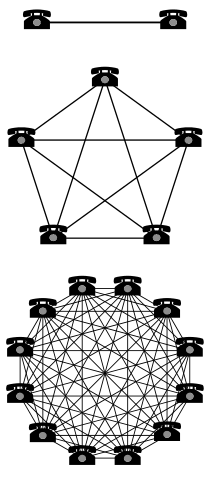
⤴️ The Warp Effect curves humanity's progress
Innovation = ideas + technology. The more ideas and the easier they spread the better technology. The better technology the easier it is to spread ideas. They drive each other and the curve of humanity warps.
Share this story!
If you would be the only person having a phone it would be pretty useless. No one to call. If one more person has a phone you can call each other. When a third person gets a phone, the total number of connections is three. A can call B and C, and B can call C.
When a fourth person joins we start to see how the value of the network begins increasing. Three phones, three connections. Four people, six connections.
A -> B, C, D
B -> C, D
C -> D
And if a fifth person buys a phone, the number jumps to ten possible connections. When twelve people have a phone there are 66 possible connections! You could then spend all day chatting on the phone.

Metcalfe's law
This is called Metcalfe's law (yes, another dude with a law.) It is used to describe the value of a network, a network effect.
"Metcalfe's law states the effect of a telecommunications network is proportional to the square of the number of connected users of the system."
From Wikipedia.
Of course, this not only applies to phones but also all kinds of similar networks; the internet itself is the best example. More than 4.5 billion people have an internet connection, so when one new user joins it doesn't mean one more possible connection, but 4.5 billion. For several reasons this new guy won't connect with all of us already online (language, Chinese firewall, meme shortage) but in theory he could.
Moore's law
I've written before about Moore's law. Every two years the number of transistors in an integrated circuit double without the cost going up. The growth is exponential. Twenty doublings mean one million transistors, ten more doublings, one billion transistors.
In 2017 AMD:s Epyc had 19.2 billion transistors. In 2019 it had 39.5 billion.

This is one of the most important reasons the latest version of Xbox or Playstation is more powerful than a twenty year old supercomputer. And why something equally powerful fits in our smartphones, instead of taking up an entire room. It has also made the technology so cheap that 3.5 billion people own a smartphone and 4.8 billion people have a mobile phone.
Ideas drive innovation
Harvard professor Joseph Henrich shows in his book The Secret of Our Success that it is our collective intelligence that drives humanity's progress.

Collective intelligence means sharing knowledge, spreading ideas. That made humanity take off a hundred thousand years ago, and is why the rate of progress has accelerated ever since.
But it is not only technology that helps us share ideas. We also need the freedom to share them. Democracy has also had strong growth in the last decades, with now almost four billion people living in a democratic country.
The Warp Effect
If we put them all together, Metcalfe's law, Moore's law and Henrich's collective intelligence, what do we get then?
They all make each other stronger.
The exponential growth in Moore's law made technology cheap and powerful enough to make personal computers available for the masses and connect them via the internet. That helped spread knowledge and ideas faster and broader than ever before, which created bigger and bigger economic value, that drove even faster technological development. Instead of pc's on our desks, over three billion people have supercomputers in their pockets.
More ideas accelerate technology and make it better. Better technology makes it easier to spread ideas. And on it goes.
The effect it creates is that the curve of humanity bends upward. It warps.
The curve of humanity's progress warps.
We call this the Warp effect.
By becoming a premium supporter, you help in the creation and sharing of fact-based optimistic news all over the world.


